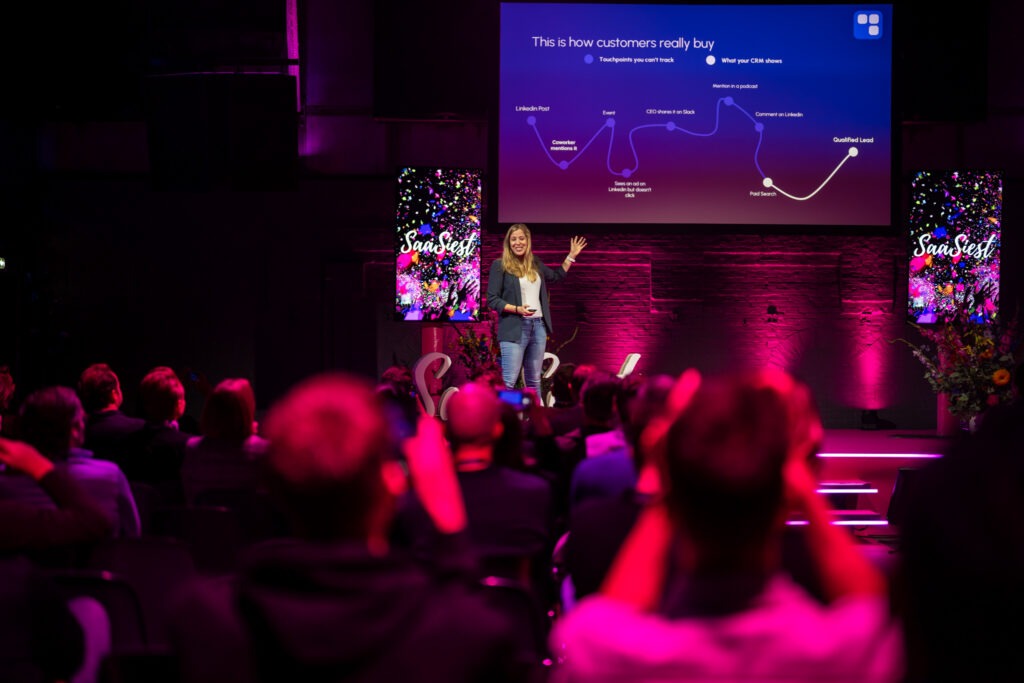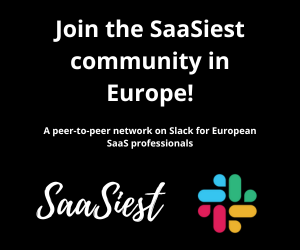
In a world where every B2B company is striving to break through the noise, Joliene van Grieken, founder of The Growth Syndicate, is setting a new standard for what it really takes to scale, and she’s not holding back. Just six weeks after welcoming her newborn son, she’s back in action at the SaaSiest Amsterdam stage, offering invaluable insights into the path from $1 million to $100 million in revenue.
Joliene’s message? Sustainable growth isn’t about quick wins or following the latest trend. It’s about building a predictable, measurable engine that drives your business forward – something so many aspire to, but few achieve. With a refreshing focus on refining every step of the journey, she’s helping companies master the art of demand generation, target the right customers, and create lasting impact. In this article, we’ll walk you through her playbook for scaling smarter and stronger.
It’s never been easier to build… or compete
Building a product has never been simpler. Advances in AI, remote hiring, and lower development costs mean companies can create robust offerings faster than ever. But with this surge in accessible technology, markets, especially in martech have become saturated. “Today, it’s easy to launch,” Joliene explains. “The hard part is differentiating in a crowded space.”
Saturated channels & rising costs
Traditional channels like LinkedIn and Google Ads have become increasingly saturated, with many companies competing for the same target audience. LinkedIn organic reach has dropped over 50%, and Google Ad CPCs have risen by 50%, making it tougher to stand out and justify ad spend. “Marketers are up against rising costs and lower organic engagement,” Joliene adds. “It’s a game of strategy now, not just volume.”
AI: Friend or foe in marketing?
While AI provides new avenues for content creation and efficiency, Joliene warns it’s also created a lot of “noise” in the market. AI tools make it easy to produce content, but they can also lead to generic, shallow marketing efforts if not used strategically. AI can elevate marketers or produce mediocrity, but it’s essentially all about how you wield it.
Facing funding challenges
With venture capital funding in a decline, companies face intense pressure to demonstrate traction and profitability quickly. For many, this means making tough calls about where to focus their limited resources. “Spreading yourself thin in this environment is a recipe for burnout,” says Joliene. The takeaway? Efficiency and focus are essential to survive today’s market pressures.
Rediscovering the roots of marketing
Marketing today is highly data-driven, but Joliene believes there’s value in returning to the fundamentals. Before 2005, marketing was about big, memorable campaigns and truly understanding the ICP. The shift to digital allowed marketers to capture leads more directly, but it also made us more focused on short-term conversions than genuine demand creation.
“What’s happening today is everyone’s chasing the same leads, but lead capture isn’t enough anymore,” she explains. Instead, we need to generate demand from those who may not be ready to buy but are prime candidates for future purchases.
Building a demand generation playbook
Instead, customers often navigate what she calls the “dark funnel”—a web of untrackable touchpoints that might include a LinkedIn post, a mention in a community forum, or a casual conversation with a colleague. These interactions are difficult to measure, yet critical to conversion. She shares the example of a buyer who, after months of following a company founder’s posts on LinkedIn, discussed the product with their CEO, finally clicked on an ad, and then made the purchase. “Performance marketing often gets the credit for that final click, but the real journey started long before,” Joliene points out.
To successfully drive demand in this “dark funnel,” she recommends doubling down on a single, high-potential ICP rather than diluting efforts across multiple personas. “Focusing on your best customers lets you refine your messaging, sales, and product efforts, and ultimately multiplies your impact without spreading yourself too thin,” she explains.
Ideal customer profiles vs. personas
One common mistake Joliene highlights is confusing ICPs with personas. In B2B, decision-makers, buyers, and users are often distinct roles. “Each of these roles has unique needs within the buyer journey,” she says. By understanding the true ICP rather than relying on superficial personas, companies can create far more effective marketing and sales efforts.
Thought leadership as a growth engine
Generating demand hinges on becoming a trusted thought leader. “If you remember one thing from this talk, it’s this: thought leadership fuels demand,” Joliene insists. Instead of focusing solely on the 5% of customers actively seeking solutions, she encourages companies to connect with the 95% who are not yet in-market. Over time, these connections foster brand recognition and preference, positioning the company as a top choice when the customer is ready to buy.
Crafting your thought leadership perspective
True thought leadership requires more than just expertise. It involves sharing a unique perspective that changes how others think or work. Joliene advises narrowing focus to a single area of interest and forming a clear “umbrella opinion” that encapsulates your stance. “People remember specialists,” she notes. “It’s easier to stand out when you’re known for one big idea, rather than juggling many.”
To generate content that sparks conversation, Joliene suggests combining a specific topic with a bold opinion. A powerful example is Adam Robinson, whose umbrella opinion centers on the belief that the old marketing and sales playbook is obsolete. Love him or hate him, people remember his perspective because it’s focused and distinct.
Maximizing touchpoints with the ICP
In a non-linear customer journey, creating multiple touchpoints is crucial. Thought leadership, SEO, webinars, events, and outbound marketing all provide ways to nurture relationships with your ICP. “The goal is to maintain visibility and credibility, even if you can’t track every interaction,” she says.
By aligning thought leadership with the sales process, marketing becomes an integrated part of the customer journey rather than an isolated effort.
Next steps for sustainable growth
Joliene distills her advice into five actionable steps:
- Accept the messy, hard-to-measure customer journey – Embrace the dark funnel and engage customers across varied touchpoints.
- Focus on one ideal customer profile – Identify and double down on the ICP that resonates most.
- Develop a strong thought leadership perspective – Stand out by becoming known for a single, clear opinion.
- Maximize valuable touchpoints – Ensure your brand is present in non-linear ways, from LinkedIn to email to in-person events.
- Align thought leadership with the sales process – Sync marketing’s message with sales for a cohesive customer journey.
In today’s B2B world, it’s important to create meaningful demand by understanding and reaching your ideal customer. With the right focus, a strong thought leadership approach, and an understanding of the modern customer journey, companies can overcome the challenges of saturation, competition, and funding pressures.
As Joliene concludes, “Our job as marketers is to understand how customers want to buy and help them do so.”




